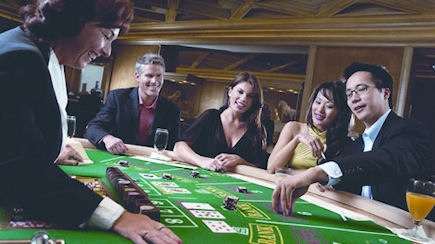This article first appeared in the Nov/Dec 2010 issue of World Gaming magazine.
Baccarat is the king of casino games in Macau and across Asia, but the ultimate in big scores and bragging rights comes from winning a major baccarat tournament. It can be a life-changing experience as first prize of a big tournament can be millions of dollars. Over the next few issues of World Gaming our casino strategy guru Andrew Scott shows you how to take that big baccarat tournament down!
When you play normal baccarat in a casino, you’re trying to pick whether banker or player will come up, and bet accordingly. You’re trying to win cold hard cash. The ironic thing about winning a baccarat tournament is that you don’t necessarily have to win chips and increase your stack; you just have to do better than the other players – by winning more (or losing less) than your opponents.

Winning a baccarat tournament is all about money management. You need to know how much you’ve got, how much they’ve got, and make bets that give you the biggest chance of finishing up with more chips than the other players. You actually don’t care whether you have a lot of chips or hardly any chips; the key thing here is the difference between your stack and their stacks.
Before we get into actual hand-by-hand strategies, let’s look at some of the general concepts that all tournament specialists need to know.
Betting order is very important. Unlike normal cash-game baccarat, the order players bet in is crucial. If you can see on which side (banker or player) your opponent has bet, or how much he has bet, or more usually both, that gives you vital information upon which to base your bet. Let’s say you have 100,000 in chips and a key opponent you are trying to stay in front of has 90,000 in chips. Now you see your opponent bet 20,000 chips on player. You can just bet 20,000 on player too! This is known as ‘flowing’ a player. Now it doesn’t matter whether banker, player or tie comes up, you will still finish the hand 10,000 chips in front of your opponent. Because of this phenomenon, players are required to bet in strict order, just like when playing poker. The difference is that play moves around a baccarat table anti-clockwise whereas poker play moves clockwise.
Understand the ‘first bet’ marker. Because betting order is important, baccarat tournaments make use of a ‘first bet’ marker. This is a bit like a dealer button in poker, but indicates the first person to bet instead of the last. Just like in poker, the marker moves on to the next player after every hand (but anti-clockwise instead of clockwise), so that every player gets his fair share of the different positions in the betting order. Once the marker has made it all the way around the table once that is known as a ‘lap’ or an ‘orbit’. Very occasionally tournaments will have a rule that the ‘first bet’ marker does not move on after a tied hand. This doesn’t make much difference as ties only occur on about 10 percent of the hands.
You have a big edge over those on your left. We’ve just seen that when you bet after a player, you have a big advantage over him. Conversely, when he bets after you, he has a big advantage over you. Players on your left usually bet before you and players on your right usually bet after you (depending on the precise position of the ‘first bet’ marker). So you have an edge over those on your left and those on your right have an edge over you. The closer the player, the bigger the edge. Worry more about opponents on your right, and less about those on your left. Being behind a player on your immediate right by a certain number of chips is a substantially bigger problem than being behind a player on your immediate left by the same amount of chips, especially if the opponent on your right knows how to use his position effectively.
Banker is the most likely outcome of any hand. Because of the drawing rules of baccarat, banker wins 45.9 percent of the time, player wins 44.6 percent of the time, and the tie wins 9.5 percent of the time.

Only bet the tie on the last hand. The tie is a very high house advantage bet. Ties occur on only 9.5 percent of the hands yet the bet pays just 8 to 1. This gives the house a 14.5 percent edge on the bet and if you turnover too much on it you’ll soon find your bankroll dwindling. It’s best to almost totally avoid betting on the tie, however ironically almost all final hand strategies involve a crucially important bet on the tie. This is because by the time you get to the last hand, compounding house edge is no longer a major consideration. Instead, locking up the highest chance of beating your opponent becomes the primary goal. There will be more to say on this later but for now just remember: never bet on the tie until the last hand, where you will almost always be betting the maximum bet on the tie.
Know the default bet. Even with the 5 percent commission, banker is a very slightly better bet than player. In the absence of any reason to bet one way or the other, your default bet is banker, but you’re ready to abandon that default for a variety of reasons (we’ll start discussing these reasons in part B of this series). Those reasons grow the deeper you get into the tournament. If the house takes no commission on winning bets but pays only 1 to 2 (or 50 percent) on banker wins on a total of 6, the player becomes the better (and therefore default) bet.
Tracking hands. Of course we all know a baccarat hand must use 4, 5 or 6 cards. It turns out the average number of cards used in a hand of baccarat is precisely 4.94. This is so close to 5 that you can just think of it as 5 cards. You can use this knowledge to track the hands and calculate how close to the end of the tournament you are. This is crucial information. Lets say a tournament uses an eight-deck shoe and ten cards are burnt off the top and another ten cards are cut off the back of the shoe. That means (8 x 52) – 10 – 10 = 396 cards will be used before the cut card emerges, which will be about 80 hands of baccarat. By keeping track of the hands, you can know how many hands are left. This is like watching the clock in a sporting match and knowing how much time is remaining. Well in advance of the end of the shoe, you can calculate who will be betting early and who will be betting late on the crucial last few hands. Usually seats are pre-assigned in a tournament, but if you were lucky enough to be able to choose your own seat and you knew where the ‘first bet’ marker would start (it usually starts at position 1 at the table), you could do the math and discover which seat was most likely to be betting last (or late) on the last round. This is the best seat. (Note: very occasionally the casino will not move the ‘first bet’ marker to the next player after a tie – under this rule the marker moves on every 5.46 cards on average.)
Know when to use your secret bets. Most baccarat tournaments make use of a limited number of secret bets. These bets completely negate the disadvantage of having to bet first (or early) in a round, as the bet is not placed on the layout but written in secret on a piece of paper and handed to the game supervisor. The bet is not declared until after all other players have bet. This is the equivalent of betting last, but out of order. Of course never waste a secret bet when you were going to bet last (or late) anyway! Without exception, always save one secret bet for the final hand (if you bust out before the last hand, you should still have one secret bet intact). If you get more than one secret bet (many tournaments give up to three), save one for the last hand, and use the others when you have to bet first (or at least earlier than your most serious opponents) for the last few times. Or you can simply save the second secret bet for the second-last hand, the third secret bet for the third-last hand, and so on.
Don’t confuse pass cards with secret bets. Some baccarat tournaments use pass cards. These are not secret bets, but merely allow you to ‘bet zero’ on this hand. These are not very important as there is often very little difference between betting zero and betting the minimum. If I were in a tournament with pass cards I would save them for the very end as they might come in useful on the last hand or last few hands. I can’t ever see them making a difference early in the tournament. There should be no reason why you can’t use a pass card (if you have one) on a secret bet, but if you ever do that be careful not to hand the pass card in with the secret bet! Your opponents will have a pretty good idea of what you have bet!
Now that you understand the general concepts of tournament baccarat, the next step is considering specific betting strategies. In the next issue of World Gaming, we’ll move on to part B of ‘How to Win a Baccarat Tournament’ which will explain the crucial difference between the ‘early going’, the ‘middle going’, and the ‘death’ – and how you bet very differently at each of these stages.







